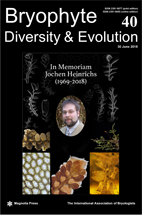Abstract
Frullaniaceae are the most diverse family of leafy liverworts preserved in amber and are known from several deposits dating from the Miocene to the Early Cretaceous. In the fossil record, Frullania is represented by 15 species as well as the extinct genera Pseudofrullania, Protofrullania and Kaolakia. Here, we describe another species of Frullania from Bitterfeld amber (Germany) as Frullania grabenhorstii sp. nov. A combination of characters associated with the leaf lobe, leaf lobule, underleaf, branching patterns, and perianth distinguishes it from all other known extant and extinct taxa. Many characters of the new fossil are shared with F. subg. Frullania sect. Australes, especially the morphologically similar extant species F. incumbens and F. subincumbens-both of Australasia. Another similar species, Fullania densiloba, occurs in Japan. These distribution patterns reinforce previously described affinities of the Baltic and Bitterfeld bryophyte floras to the extant flora of Asia and Australasia. This pattern has been found in several taxa, e.g., Notoscyphus, Nipponolejeunea, and Metacalypogeia. The new fossil is compared with other species from Bitterfeld, Baltic, and Rovno amber, which show significant morphological differences. In addition to the description, we provide an overview of the family Frullaniaceae in different amber deposits.

